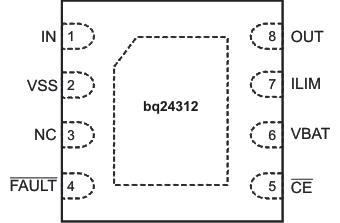SLUS912A August 2009 – August 2015
PRODUCTION DATA.
- 1 Features
- 2 Applications
- 3 Description
- 4 Revision History
- 5 Pin Configuration and Functions
- 6 Specifications
- 7 Detailed Description
- 8 Application and Implementation
- 9 Power Supply Recommendations
- 10Layout
- 11Device and Documentation Support
- 12Mechanical, Packaging, and Orderable Information
Package Options
Mechanical Data (Package|Pins)
- DSG|8
Thermal pad, mechanical data (Package|Pins)
- DSG|8
Orderable Information
5 Pin Configuration and Functions
DSG Package
8-Pin WSON With Exposed Thermal Pad
Top View

Pin Functions
| PIN | I/O | DESCRIPTION | ||
|---|---|---|---|---|
| NAME | NO. | |||
| CE | 5 | I | Chip enable input. Active low. When CE = High, the input FET is off. Internally pulled down. | |
| FAULT | 4 | O | Open-drain output, device status. FAULT = Low indicates that the input FET Q1 has been turned off due to input overvoltage, input overcurrent, battery overvoltage, or thermal shutdown. | |
| ILIM | 7 | I/O | Input overcurrent threshold programming. Connect a resistor to VSS to set the overcurrent threshold. | |
| IN | 1 | I | Input power, connect to external DC supply. Connect external 1 μF ceramic capacitor (minimum) to VSS. | |
| NC | 3 | These pins may have internal circuits used for test purposes. Do not make any external connections at these pins for normal operation. | ||
| OUT | 8 | O | Output terminal to the charging system. Connect external 1 μF ceramic capacitor (minimum) to VSS. | |
| VBAT | 6 | I | Battery voltage sense input. Connect to pack positive terminal through a resistor. | |
| VSS | 2 | — | Ground terminal | |
| Thermal PAD | — | — | There is an internal electrical connection between the exposed thermal pad and the VSS pin of the device. The thermal pad must be connected to the same potential as the VSS pin on the printed circuit board. Do not use the thermal pad as the primary ground input for the device. The VSS pin must be connected to ground at all times. | |